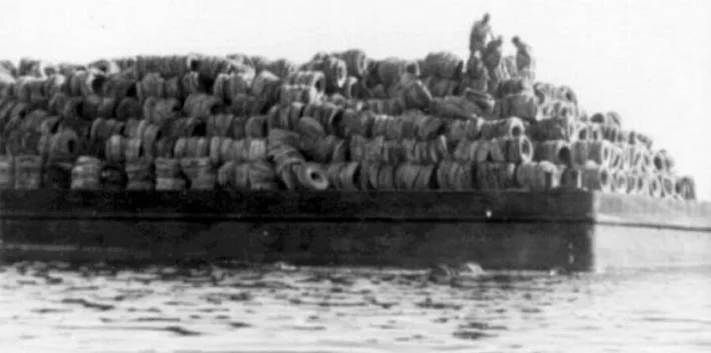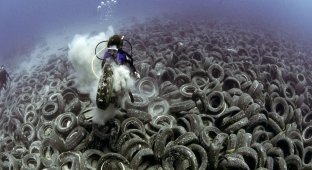Toxic reefs. 2 million tires flooded in Florida, what happened to them 50 years later (6 photos)
In the 1970s, residents of Florida (USA) were faced with a problem - tires that simply had nowhere to go. Until humanity came up with a way to recycle used things, they were simply thrown into landfills. And these landfills were not located at special landfills, but near large cities, and over time they became larger and larger. 
In Florida, the problem of tire disposal was solved in a very unusual way. Why make huge tire dumps on land when you can dump them in the water? Fish accustomed to living among reefs will be able to settle there. Therefore, state authorities decided to create artificial reefs, providing habitat for commercial fish.
They already had experience creating artificial reefs for breeding commercial fish. But previously concrete was used for this purpose, and construction cost a lot of money. The idea of making a reef out of tires seemed very rational, since it would solve two problems at once - recycle the tires and help the fishery.
One of the authors of the project, Gregory McIntosh, inspired the authorities with his idea:
“Tires that pollute the land and look terrible can be very useful! We will create a fishing reef out of them!”
In the spring of 1974, state authorities approved the project, and employees of the US Army Corps of Engineers, together with fishermen, began to implement the idea. They marked out the area and sank 2 million car tires to the bottom of the Atlantic Ocean. The structure was named Osborne Reef. 
Its area was about 15 hectares. The reef was located about 2 km from the coast at a depth of 20 meters off the east coast of Florida. To prevent the tires from scattering on the ocean floor, they were securely connected with metal clamps and nylon ropes.
As conceived by the authors of the project, coral reefs were supposed to attach themselves to the surface of the tires and begin to grow, creating a home for fish. At first everything went according to plan - the corals actually began to colonize the new surface. In 25 years, about 10% of the artificial reef was already overgrown with corals and this was a pretty good indicator. 
But then something went wrong. Under the influence of salty sea water, the metal ties began to disintegrate and the tires began to separate from each other. The structure, which seemed reliable, crumbled. And instead of helping the aquatic environment, the tires began to harm it. They destroyed existing corals and prevented new ones from forming.
Why can sunken ships become a refuge for flora and fauna, but this is not the case with tires? Tires are too light. They are swept away by tides and powerful storms before marine flora and fauna have a chance to inhabit and establish themselves. And the tires scattered all over the seabed are toxic. 
The tires that fell out of the structure scattered along the ocean floor. Underwater currents, sea winds and storms carried them further and further and threw them ashore.
The tires not only clogged the water, but also the nearby beaches. And that's only half the story. The material from which they are made releases about 120 different carcinogens that harm marine life. And water provokes the release of these dangerous substances and spreads them throughout the ocean. 
To prevent the situation from reaching the scale of an environmental disaster, the government and a team of enthusiasts. But getting them from the bottom turned out to be much more difficult and expensive than dumping them there. 
On average, removing one tire cost $17 in the early 2000s (more than $30 today). In 2007, the military recovered 73 thousand tires from the bottom, and this was the most successful attempt of the entire campaign.
Even if the ocean floor is completely cleared of remaining tires, colossal harm has already been caused to nature. According to ecologists, it will take approximately 50 years to restore the ecosystem and form new coral reefs.

























